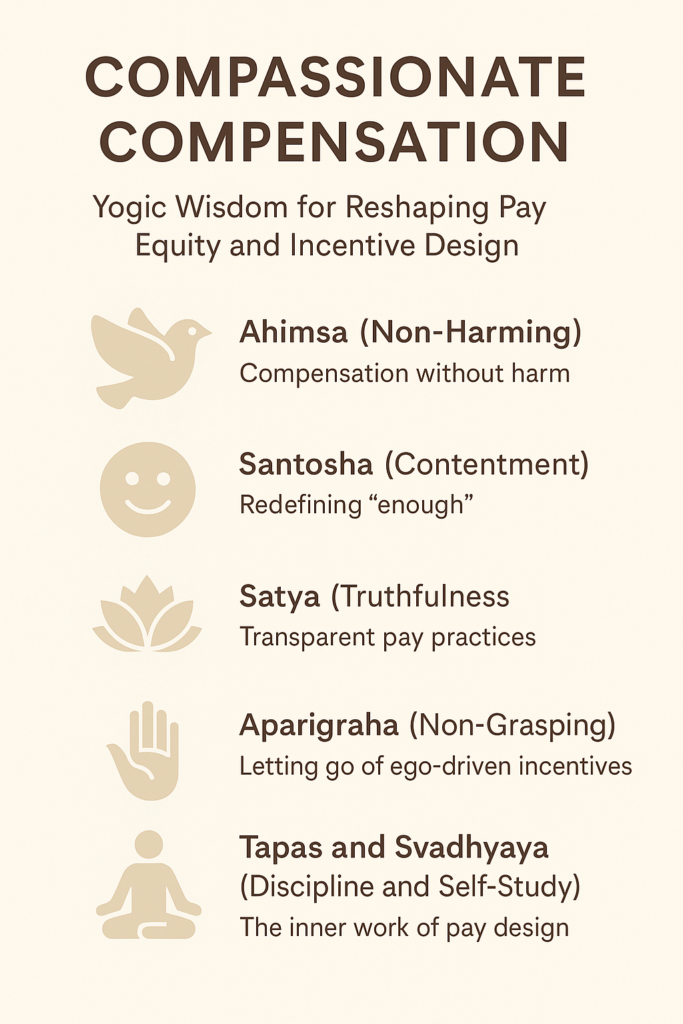As both a yoga teacher and HR professional specializing in total rewards, I’ve spent years navigating two seemingly different worlds: one rooted in inner awareness and ancient philosophy, the other in compensation metrics, labor market trends, and fiscal responsibility. But over time, I’ve found they are not mutually exclusive. In fact, yoga philosophy offers a deeply humanizing lens for examining one of HR’s most complex and emotionally charged responsibilities: compensation.
What Is Compassionate Compensation?
Compassionate compensation means designing and delivering pay practices that are not just competitive or compliant, but also conscious, acknowledging the whole human behind the role. It’s a philosophy that calls for fairness, clarity, and dignity in every compensation conversation, from base pay structures to incentive design, and particularly in how we address pay equity.
Let’s explore how key principles from the Yamas and Niyamas; the ethical precepts from Patanjali’s Yoga Sutras, can guide the way we approach modern total rewards strategies.

Ahimsa (Non-Harming): Compensation Without Harm
Ahimsa, the cornerstone of yogic ethics, reminds us to act without causing harm, to ourselves and also others. In the context of compensation, this means avoiding systems that perpetuate inequity, burnout, or financial insecurity.
- Are our pay bands transparent and equitable across gender, race, and geography?
- Does our incentive structure unintentionally reward unhealthy competition or overwork?
- Are we considering the mental and emotional toll of the uncertainty of variable pay?
A compensation philosophy grounded in ahimsa leads us to build safe and stable frameworks that uplift rather than exploit.
Santosha (Contentment): Redefining “Enough”
In a culture that often measures success in dollars, santosha invites us to contemplate sufficiency.
- Are we reinforcing a culture of endless striving, or are we recognizing contributions with meaningful, sustainable rewards?
- Can our variable compensation plans reward collaboration, not just high-volume output?
- Are we linking pay only to individual achievement, or also to team success and shared values?
Santosha teaches us that contentment doesn’t mean stagnation, it means aligning rewards with purpose, not pressure.
Satya (Truthfulness): Transparent Pay Practices
Truthfulness in communication, satya, is essential for building trust. Employees today are increasingly demanding transparency in how pay decisions are made.
- Are compensation philosophies published and accessible?
- Do managers know how to explain pay decisions with clarity, compassion, without false promises or expectations?
- Are our incentive metrics fair, realistic, and clearly communicated?
Transparent compensation doesn’t mean revealing every number, but it does mean building credibility through honest, proactive communication.
Aparigraha (Non-Grasping): Letting Go of Ego-Driven Incentives
This principle teaches us to release attachment, especially to things we cling to for validation or power.
In HR, this translates to a willingness to restructure legacy pay practices that no longer serve the organization or its people.
- Are outdated commission structures reinforcing privilege or hierarchy?
- Are equity grants reserved only for the “top few,” or do they empower long-term ownership across the organization?
- Are we brave enough to redistribute incentive dollars to reflect values, not just output?
Letting go of past practices can make room for more inclusive and empowering reward structures that align with upcoming compensation trends.
Tapas (Discipline) and Svadhyaya (Self-Study): The Inner Work of Pay Design
Transforming compensation practices requires more than a new model, it requires inner work. Tapas is the fire of discipline; svadhyaya is self-inquiry.
Together, they ask:
- Are we doing the hard work of analyzing and correcting systemic pay gaps?
- Are we continuously studying market trends, internal data, and feedback to refine our approach?
- Are we willing to challenge our own assumptions about performance and worth?
Compassionate compensation isn’t soft, it’s challenging through rigorous review of data, reflection on what really works, and deeply intentional.
The Modern Workplace Needs More Than Market Benchmarks
Yes, competitive data matters. Yes, budgets and business outcomes matter. But when we embed yogic values into our compensation philosophy, we create systems that serve both the business and the individual.
We move from:
- Compliance to consciousness
- Pressure to purpose
- Scarcity to sufficiency
By grounding pay decisions in ancient wisdom, we don’t abandon modern business goals, we elevate them.
Final Notes
Imagine a workplace where equity reviews are acts of ahimsa, incentive plans promote santosha, and salary conversations are infused with satya. That’s not utopian thinking. That’s what happens when yoga meets compensation, and when compassion becomes a core metric of success.
In the end, the most valuable currency we offer our employees may not be stock options or bonuses, it may be the feeling that they are seen, respected, and valued.